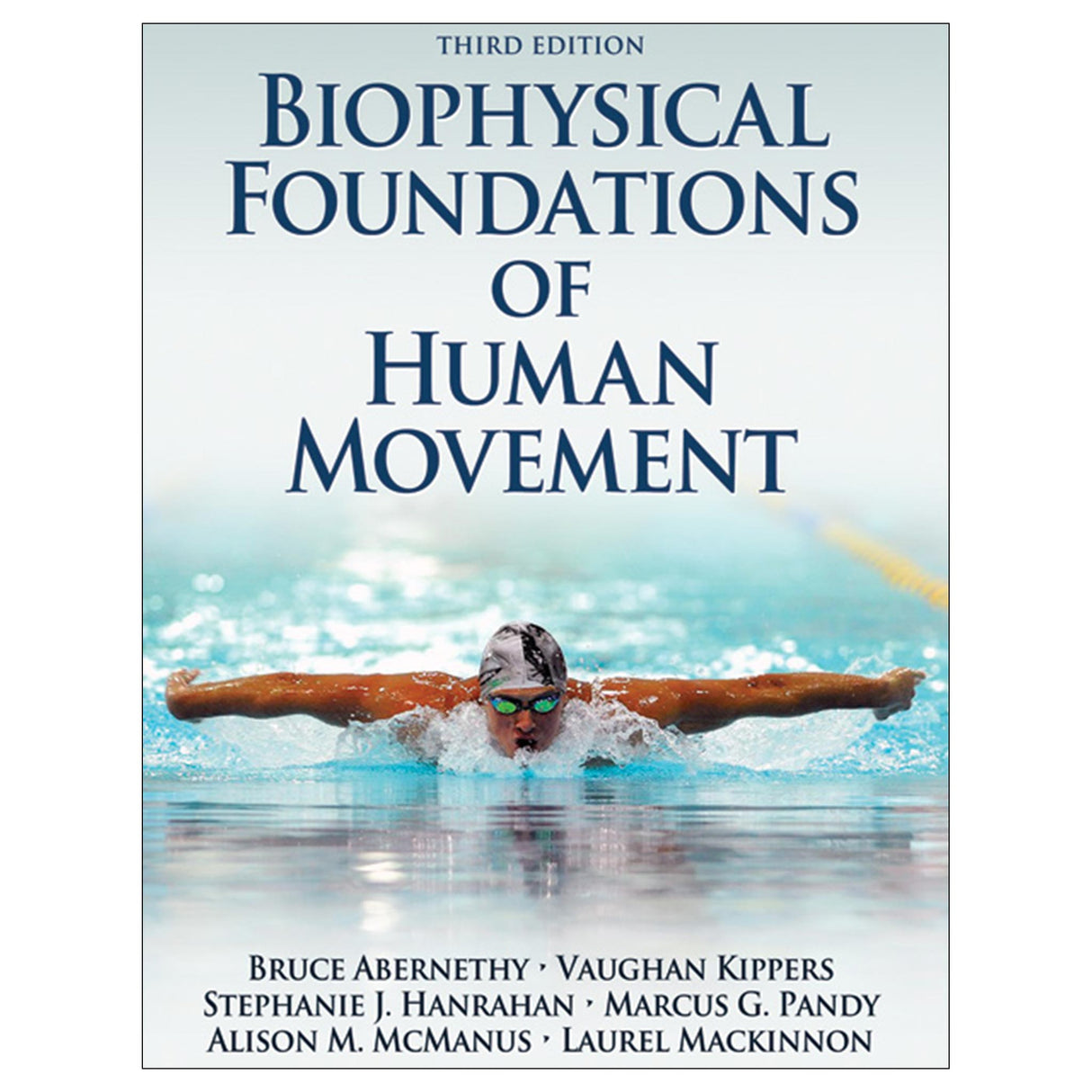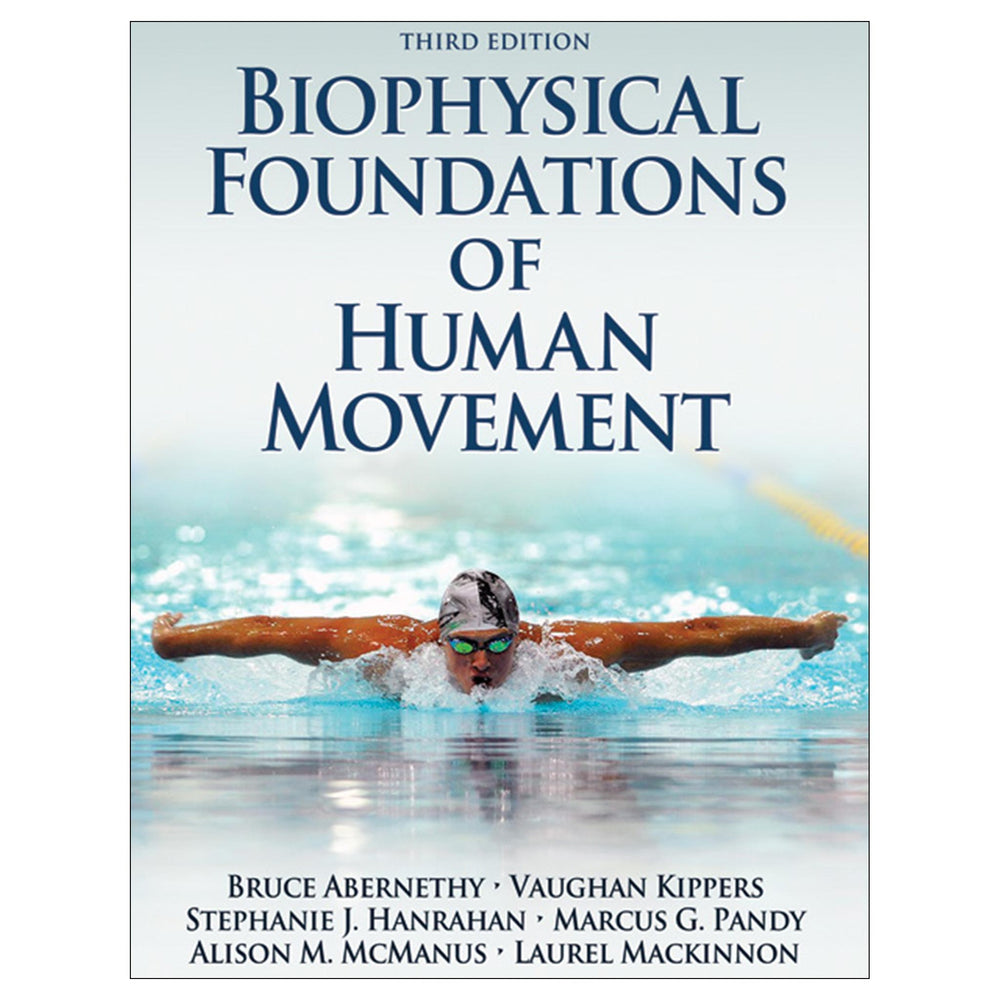Biophysical Foundations of Human Movement 3rd Edition PDF
Author: Bruce Abernethy, Vaughan Kippers, Stephanie J. Hanrahan, Marcus G. Pandy, Ali McManus, Laurel Mackinnon
$74.00 USD
Access Duration: 10 Years
Biophysical Foundations of Human Movement, Third Edition, introduces readers to key concepts concerning the anatomical, mechanical, physiological, neural, and psychological bases of human movement. The text provides undergraduate students with a broad foundation for more detailed study of the subdisciplines of human movement and for cross-disciplinary studies. Readers will learn the multi-dimensional changes in movement and movement potential that occur throughout the life span as well as those changes that occur as adaptations to training, practice, and other lifestyle factors.
This third edition includes the latest research and improved presentation to address areas of growth and change in the fields of human movement. The following are important updates to this edition:
- A new chapter on historical origins of human movement science provides students with an appreciation of the development of the field as well as its future directions.
- Content regarding exercise physiology has been reorganized to provide more discrete coverage of key concepts in nutrition.
- A new concluding section focuses on applications in the areas of prevention and management of chronic disease, prevention and management of injury, and performance enhancement in sport and the workplace, as well as the benefits of sport and exercise science to work, sport, and everyday living.
- Ancillary materials support instructors in teaching across disciplines as they assist students in understanding the breadth of content in this comprehensive text.
Using a modular approach to teaching sport and exercise science, Biophysical Foundations of Human Movement, Third Edition, offers students a structured understanding of how the subdisciplines work independently and in tandem. Following a general introduction to the field of human movement studies, readers are introduced to basic concepts, life-span changes, and adaptations arising in response to training in each of the five major biophysical subdisciplines of human movement. Each subdiscipline is given a brief introduction, including the definition and historical development of the subdiscipline, the typical issues and problems it addresses, the levels of analysis it uses, and relevant professional training and organizations. Multi-disciplinary and cross-disciplinary approaches to human movement are also discussed along with contemporary applications. By studying the integration of knowledge from a number of the biophysical subdisciplines, students will be better prepared for advanced study and careers reliant on the integration of knowledge from various disciplines and perspectives.
The third edition offers tools for retaining the material, including learning objectives and summaries in each chapter, a glossary, and lists of web-based resources. Throughout the text, special “In Focus” features highlight key organizations, individuals, and studies from around the world that have contributed to the current understanding of human movement. These features help readers appreciate the evolution of the field so that they may better understand its direction. Students interested in further study will find specialized texts for each of the subdisciplines listed in the Further Reading and References section of each chapter along with updated lists of websites.
The third edition of Biophysical Foundations of Human Movement offers a comprehensive introduction for students, scientists, and practitioners involved in the many professions grounded in or related to human movement, kinesiology, and sport and exercise science. By considering the effect of adaptations in each of the biophysical subdisciplines of human movement, Biophysical Foundations of Human Movement also illustrates the important role physical activity plays in the maintenance of health throughout the life span.
Part I: Introduction to Human Movement Studies
Chapter 1. Human Movement Studies as a Discipline and a Profession
What Is Human Movement Studies and Why Is It Important?
Disciplines and Professions
Is Human Movement Studies a Discipline?
Structure of a Discipline of Human Movement Studies
What Should the Discipline of Human Movement Studies Be Called?
Professions Based on Human Movement Studies
Professional Organisations
Relationships Between the Discipline and the Professions
Summary
Further Reading and References
Chapter 2. Historical Origins of the Academic Study of Human Movement
Scholarly Writings on Human Movement From Ancient Civilisations (ca. 1000 BC-350 AD)
The Middle Ages as a Period of Suppression of the Study of Human Movement (ca. 350-1350 AD)
Scholarly Works on Human Movement From the Renaissance and Reformation Periods (ca. 1350-1650 AD)
Scholarly Works on Human Movement During the Period 1650-1885
Professionalization of Physical Education During the Period 1885-1929
Organisation of Research Efforts in Physical Education During the Period 1930-1959
Beginnings of a Discipline of Human Movement Studies During the Period 1960-1970
Emergence of Subdisciplines and Specialisations, 1970-Present
Future Directions, Challenges, and Opportunities
Summary
Further Reading
Part II: Anatomical Bases of Human Movement: Functional Anatomy
Chapter 3. Basic Concepts of the Musculoskeletal System
Tools for Measurement
Skeletal System
Articular System
Muscular System
Summary
Further Reading
Chapter 4. Basic Concepts of Anthropometry
Definition of Anthropometry
Tools for Measurement
Body Size
Determination of Body Shape
Tissues Composing the Body
Somatotyping as a Description of Body Build
Human Variation
Summary
Further Reading and References
Chapter 5. Musculoskeletal Changes Across the Life Span
Definitions of Auxology and Gerontology
Tools for Measurement
Physical Growth, Maturation, and Ageing
Age-Related Changes in the Skeletal and Articular Systems
Age-Related Changes in the Muscular System
Changes in Body Dimensions Across the Life Span
Methods of Determining Age
Summary
Further Reading
Chapter 6. Musculoskeletal Adaptations to Training
Effects of Physical Activity on Bone
Effects of Physical Activity on Joint Structure and Ranges of Motion
Effects of Physical Activity on Muscle–Tendon Units
Effects of Physical Activity on Body Size, Shape, and Composition
Summary
Further Reading and References
Part III: Mechanical Bases of Human Movement: Biomechanics
Chapter 7. Basic Concepts of Kinematics and Kinetics
Vectors
Motion
Generalized Coordinates and Degrees of Freedom
Force
Moment of Force
Force Analyses
Equations of Motion
Computer Modeling of Movement
Summary
Further Reading
Chapter 8. Basic Concepts of Energetics
Kinetic Energy
Potential Energy
Total Mechanical Energy
Power
Elastic Strain Energy
Metabolic Energy Consumption
Efficiency of Movement
Summary
Further Reading
Chapter 9. Biomechanics Across the Life Span
Biomechanics of Normal Gait
Changes in Muscle Strength with Age
Gait Development in Children
Gait Changes in Older Adults
Summary
Further Reading
Chapter 10. Biomechanical Adaptations to Training
Muscular Adaptations to Training
Neuromuscular Adaptations to Training
Training to Prevent Anterior Cruciate Ligament Injury
Biomechanical Adaptations to Injury
Dependence of Motor Performance on Changes in Muscle Properties
Using Computer Modelling to Study Vertical Jumping Performance
Insights Into the Effects of Training Provided by Computer Models
Summary
Further Reading
Part IV: Physiological Bases of Human Movement: Exercise Physiology
Chapter 11. Basic Concepts of Exercise Metabolism
Production of Energy for Exercise
Oxygen Supply During Sustained Exercise
VO2max as an Indicator of Endurance-Exercise Capacity
Measurement of Exercise Capacity
Human Skeletal Muscle Cells
Summary
Further Reading
Chapter 12. Basic Concepts of Nutrition and Exercise
Energy Requirements of Exercise
Nutrients for Exercise
Fluid Requirements During Exercise
Summary
Further Reading
Chapter 13. Physiological Capacity Across the Life Span
Responses to Exercise in Children
Exercise in Older Adult Life
Summary
Further Reading and References
Chapter 14. Physiological Adaptations to Training
Training-Induced Metabolic Adaptations
Immediate and Anaerobic-System Changes After High-Intensity Sprint and Strength Training
Changes in Aerobic Metabolism After Endurance Training
Endurance Training-Induced Changes in the Cardiorespiratory System
Endurance Training-Induced Respiratory Changes
Endurance Training-Induced Changes in Lactate Threshold
Changes in the Muscular System After Strength Training
Basic Principles of Training
Continuous and Interval Training
Training for Cardiovascular Endurance
Methods of Strength Training
Causes of Muscle Soreness
Summary
Further Reading
Part V: Neural Bases of Human Movement: Motor Control
Chapter 15. Basic Concepts of Motor Control: Neuroscience Perspectives
Nervous System as an Elaborate Communications Network
Components of the Nervous System
Neurons and Synapses as the Building Blocks of the Nervous System
Sensory Receptor Systems for Movement
Effector Systems for Movement
Motor Control Functions of the Spinal Cord
Motor Control Functions of the Brain
Integrative Brain Mechanisms for Movement
Summary
Further Reading
Chapter 16. Basic Concepts of Motor Control: Cognitive Science Perspectives
Using Models to Study Motor Control
Key Properties to be Explained by Models of Motor Control
Information-Processing Models of Motor Control
Some Alternative Models of Motor Control
Summary
Further Reading
Chapter 17. Motor Control Changes Throughout the Life Span
Changes in Observable Motor Performance
Changes at the Neurophysiological Level
Changes in Information-Processing Capabilities
Summary
Further Reading
Chapter 18. Motor Control Adaptations to Training
Changes in Observable Motor Performance
Changes at the Neurophysiological Level
Changes in Information-Processing Capabilities
Factors Affecting the Learning of Motor Skills
Summary
Further Reading
Part VI: Psychological Bases of Human Movement: Sport and Exercise Psychology
Chapter 19. Basic Concepts in Sport Psychology
Personality
Motivation in Sport
Self-Determination Theory
Arousal, Anxiety, and Sport Performance
The Practice of Applied Sport Psychology
Imagery: An Example of Psychological Skill
Summary
Further Reading
Chapter 20. Basic Concepts in Exercise Psychology
Effects of Psychological Factors on Exercise
Effects of Exercise on Psychological Factors
Summary
Further Reading
Chapter 21. Physical Activity and Psychological Factors Across the Life Span
Changes in Personality
Psychosocial Development Through Sport Participation
Exercise in the Aged
Termination of Athletic Careers
Summary
Further Reading
Chapter 22. Psychological Adaptations to Training
Aerobic Fitness and the Response to Psychological Stress
Changes in Personality
Changes in Motivation: Staleness, Overtraining, and Burnout
Changes in Mental Skills
Summary
Further Reading
Part VII: Multi- and Cross-Disciplinary Applications to Human Movement Science
Chapter 23. Applications to Health in Chronic-Disease Prevention and Management
Major Causes of Disease and Death Globally
Cost of Physical Inactivity
Measuring Physical Activity and Sedentary Behavior
Levels of Physical Activity in Adults and Children
Recommendations for Physical Activity
Summary
Further Reading
Chapter 24. Applications to Health in Injury Prevention and Management
Preventing Manual-Lifting Injuries in the Workplace
Preventing and Managing Overuse Injuries in Sport
Preventing Injuries Related to Osteoporosis
Summary
Further Reading
Chapter 25. Applications to Performance Enhancement in Sport and the Workplace
Talent Identification
Performance Optimization
Summary
Further Reading and References
"The book is made up of standalone sections that make reading easy and understandable. The authors are well-respected scientists in the field, and the information they provide throughout originates from evidence-based research."
--Doody's Book Review (5 Star Review)
The three components of motivation affect exercise adherence
Training can increase both muscle strength and fiber contraction speed
Instructor guide. Includes a sample course syllabus, learning objectives, and teaching tips and suggestions for class projects.
Test package. Includes a bank of more than 300 questions. The test package is available as a rich text file through Respondus software that allows instructors to create their own tests by selecting from the question pool. It may also be used through a learning management system such as Blackboard or Moodle.
Image bank. Includes all of the figures, tables, and photos from the text, sorted by chapter, and can be used in developing a customized presentation based on specific course requirements.





